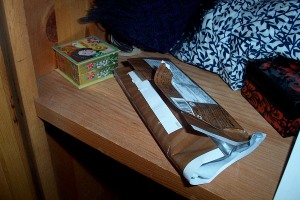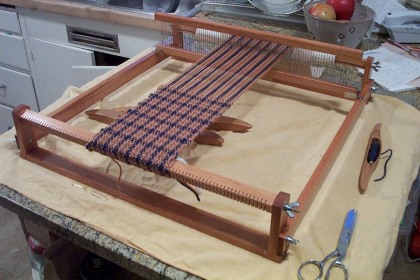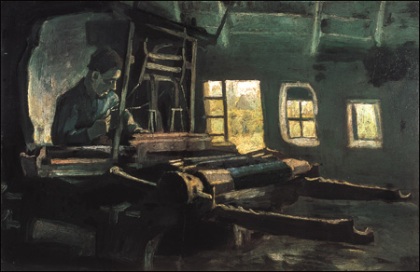Home For a Head
December 1, 2008
I appreciate your sympathetic comments on my last post. I’m ashamed how whiney and alarmist I sound–“Waa, I’m afraid I can’t weave!”–when so many of you are already been biting the bullet (and the anti-inflamatories) to pursue the beloved craft. Forgive me; I ought to give you some context: as someone with a chronic illness, I’ve had a lot of experience with physical things going wrong and not getting better. It’s turned me into a human barometer. I’m all about reading the warning signs, catching little problems, and working to forestall them before they take permanent hold. I have found that if I take ibuprophin and give in to my “bloody mindedness” as Deborah puts it (love that expression!), I have to be ready for it to reach round and bite me. Sometimes it’s worth it, mostly not. It’s more of a crap shoot when the problem is an unfamiliar one.
Last week we discovered a possible escape route from our disturbing landlord and his 5:30 AM-on-a-Sunday-morning (sledge?)hammering in the other half of the duplex. Landlord and new girlfriend are in a frenzy of loud and smelly home improvement, which I think means they are here for the long haul. –This, and the fact that they have hung shiny new Tibetan prayer flags across the yard at just the hight to decapitate themselves in the dark. Der Mann says it has spoiled prayer flags for him.
It will be a couple of months before we know whether this escape route pans out, and the strange thing is I don’t really mind one way or the other. It seems I didn’t need to know for sure we were getting away from here to feel better, I just needed the possibility that we might be living somewhere else in the foreseeable future.
I am half convinced that organizing my weaving area is what brought this possibility about.
I bought a new-to-me weaving cupboard in the spring, but couldn’t use it until I had attached the dangerously balanced hutch to the base. Since then, “not using” the cupboard has translated into stuffing things into it just to get them out of the way. You know, weaving things like Chinese face powder (I don’t wear make-up, but it’s a pretty box!) and my chocolate stash.
The more I stuffed, the more I would have to remove when I finally pulled the cupboard out from the wall to attach the hutch. I was unmotivated. More recently I didn’t see any point in fixing up the cupboard until we decided whether we were going to try to find a new apartment.
A couple of weeks ago I gave up on finding another apartment; the prospects were too dismal. I attached the hutch to the base cupboard with metal mending plates and organized all my weaving things inside.
There isn’t much difference between the before picture and the after picture, but it is a huge difference for me, because now I know where everything is! I wish I could show you the annoying places around the house where reeds, beaming sticks (that’s what the wooden blinds are going to be, too) and the toe-stubbing pieces of my warping reel were crammed.
I’m inclined to see a connection between cupboard fixing and landlord escape because it is an example of something I keep noticing in life, but only ever after it happens: the power of gestures of despair. When I give up, and take action reflecting the up-givenness, circumstances alter. It’s not a useful philosophy because it’s not possible to give up on purpose (not the way I’m talking about), but there it is.
The best part about my reorganized corner is that I now have space for my head, or rather, my father’s head. One of the most frustrating things about our current cramped living situation is that it has coincided with my grandmother wanting to give me what little remains of my dead father’s stuff (he died when I was 3). Since my grandmother is at a stage of obsessively throwing things away, when she offers, I take–pronto–or else risk never seeing the object again.
My father carved the head when he was in high school. For years it sat in the murky top recess of the built-in shelves that held my grandmother’s stereo and TV. I’m unaccountably fond of it. I think he had been looking at pictures of the Easter Island heads the night he made it. Here it is looking monolithic:
And here is its sterner side:
I felt uncomfortable having it sitting on the floor behind my loom. It seemed disrespectful. For Christmas, I’m going to dress it up as the Green Man.
At Loose Ends
November 25, 2008
Over the last months I have been listening to Weavecast, starting with the oldest episodes and slowly working my way toward the more recent. Syne Mitchell confesses to an early fear of warping and, in the last episode I listened to, fear of tapestry. Fear of warping makes sense to me, but what I seem to be suffering from now is fear of treadling and shuttle throwing. Weird!
More specifically I am afraid of discovering that I can’t weave on my loom any more. Sensible me says, “Warp it and see. The worst that can happen is you’ll have an unwoven warp.” Cringey me says, “Yes, but what a waste that would be, and as long as I don’t weave, I don’t have to face the bad news.”
My last project aggravated a couple joints and they seem to be bearing a grudge, no matter how sweetly I remonstrate with them. I know I mentioned the treadling problem, but I failed to mention that tying off the bunches of fringe (not twisting, just tying!) on two scarves resulted in not being able to use my gimpy right index finger for nearly two weeks. I need that finger for my mouse!
The project was to be a sampler for three baby blankets in Summer and Winter. I knew I wouldn’t be able to tackle all those blankets, which made the sampler feel kind of dreary. Meanwhile two of the babies are swiftly passing the gift stage, and the third will be arriving any time.
My problem? I am stuck immobile between weaving a preparatory sampler I don’t really want to weave, for a tardy project I doubt I am physically capable of; and ditching both the sampler warp (too short to be anything but a sampler) and the blanket plans.
Der Mann and I talk about these divergent aspects of our personalities. While Der Mann enjoys starting things, I enjoy carrying them to completion. I don’t experience pleasure in simply starting a project. In fact, I have trouble understanding it even when he explains it to me. The birth of the idea itself isn’t the fun part for me. For me, the reward is in seeing how the idea grows up to become something.
Arbitrary activity bores me to the point of hives (I have loathed board games since I was a kid) but when I am on the trail of an end result that interests me, I can pursue it to ridiculous lengths, happy as a clam. This isn’t perseverance, as Der Mann thought it was before I told him my secret. It’s a sort of addiction to the narrative of making things. Like a child with a story book, I demand a proper beginning, middle, and end.
It’s different from being goal oriented. I happily abandon half-read books, half-walked trails, unreached summits, boring movies, vacation plans. Goals seem very arbitrary to me most of the time. Ideas do not. It makes me nervous if the idea of a blanket already exists, but the possibility of the physical blanket has disappeared. What happens to the idea, then? Does it float away harmlessly, like a stray balloon?
According to my husband, yes, this is what ideas do, and he has the boxes of sketchbooks to prove it. To me an escaped idea feels more like one of those sets of plastic rings from a six-pack of pop that you’re supposed to cut up so it doesn’t tangle the sea creatures.
While hosting negotiations between sensible me and cringey me, I have been marking time with my rigid heddle loom. I decided to make a rigid heddle scarf for my mom and each of my aunts out of the bits of yarn remaining from Great Granny’s stash. They were all quite close to her.
Yes, I have been weaving while standing at the kitchen counter.
*Sigh!* A Wonderful Evening
July 29, 2008
Before I start, I suppose I should warn you: I am not a crass person. Not my style of humor. But I do happen to think kids throwing up is pretty funny. Growing up as the oldest of seven, with my closest half-sibling 6 years younger than me, I took my laughs where I could get them.
And to set things up even further: on Thursday, because a relative pressed money on us for helping them move, my husband and I decided to do something we never do–walk down town, have dinner in a restaurant, and see a blockbuster movie at the Regal Multiplex.
“Oh, so THAT’s why the last non-Japanese animated film we saw in a theater was Mulan, when we were in college,” was our general feeling. At 10 on a weeknight we were the only people at Wall-E. During the entire second half of the movie, bored out of my gourd as the plot cycled through all the requisite cartoon conventions, I kept thinking: this is just the same as when we watch a boring DVD at home, only at home we would be on the couch and I’d lie down with my head on der Mann’s knee and go to sleep.
The beginning was strong. (They should have kept the whole movie in the garbage dump and not allowed the robots to talk.) To get to the beginning, however, we had to run the gauntlet of the “Regal Kids” (was that what it was called?) marketing and movie previews for thirty minutes. I mean “run the gauntlet” in the traditional sense of being beaten with armored fists and stuck with small knives by drunken Vikings.
Since our TV can’t do anything but play DVD’s, media culture tends to jar us. We expect that. Our eyes bug out when we catch a half an hour of television at my relatives’ once a year. But the previews before Wall-E went far, far beyond a little eye-bugging. My husband and I stared full into the abyss of orgiastic pandering that is children’s entertainment. By the time the movie started, I was ready to scratch a hole in the ground, crawl into it, and wait for the cretinous Eloi and Morlock generations produced by these movies to grow up and eat me.
In other words, the tone of the previews totally undermined the cheery propaganda of Wall-E.
Our favorite place to walk is a trail in a valley with a creek and some woods. We were very happy to discover it this spring, because it is the only natural greenway in our new city! (The parks department here is good at sports complexes and bad at parklands.) On Sunday we went there to stretch our legs and check on the progress of the caterpiller-treaded machines that are destroying it for posterity.
Very thorough, we concluded. Then, since I was in a bad mood already I said, “Why don’t we go see Prince Caspian at the Kiggins Theater?”
I liked the Narnia books enough that I’d purposely avoided the movie version of the Lion the Witch and the Wardrobe, but I was interested in Prince Caspian because it was supposed to be a throw-away. People complained it went too far from the book. In that case, I figured I could just forget about the source material and watch it as a fantasy action film. And if we got bored we could leave because tickets are only $4 for a double feature.
The Kiggins Theater is a poured-cement art deco cinema from the 30’s that shows second run movies. It’s a surprise it’s survived in this town. I like it, though we’d only been there once before since it doesn’t usually have the movies we want to see. It’s such a home-style place that you walk inside and buy your ticket (only there are no physical tickets) from the teen-or-early-20’s person running the concession stand. And since the movie doesn’t seem to start until they’re done serving refreshments I wouldn’t be surprised if they’re also the projectionist.
There is something I really miss in modern theaters: big big screens with curtains. Of course the curtains are totally pointless (dust reduction?) if there isn’t a stage as well; I don’t know why I’m so attached to the theatrical symbolism, but I am. When all the munching masses were settled in their sprung seats at the Kiggins (many are mended with floral vinyl circa 1969) and the curtains parted on the huge screen in the huge auditorium, I felt the most wonderful “ah” of happy 1930’s expectation. Like time travel without the Morlocks. Like Life On Mars without the irony.
There were no previews, and Prince Caspian was the perfect movie to carry that feeling, since it begins with the classic cinematic device of a desperate royal escape: paneled chambers and swirled cloaks and a moonlit horse chase.
Since I wasn’t watching it as Prince Caspian, and the Pevensies didn’t show up for a while, I was totally enchanted. It just happened to be one of those films (rare for me) whose faults are the kind I find easy to forgive. As far as I’m concerned Caspian and Reepicheep carried the movie. And the location scout. And the costumes.
One of der Mann’s and my favorite things to do is get on line and read A.O. Scott’s New York Times movie reviews aloud to each other, preferably of a film we’ve already seen, the better to savor his bon mots. We happened to read the review for Prince Caspian a few months ago and I remembered Scott commenting (though he disliked the movie) on the exceptional performances of both Miraz and the young Italian actor who played the prince.
Um, no. I’d misremembered the review. The actor who played Miraz is the Italian, and very good, but I went clear through the movie thinking the actor who played Caspian was this incredible Italian ingenue: “Wow, his delivery is flawless! He’s got an almost perfect feel for the cadence of English, yet without any of that stage-brat actorishness British actors tend to bring to heroic roles!” I marveled. “They made a really good choice casting an Italian instead of a Brit! And he isn’t even very good looking!”
The remarkable thing was the way Caspian (Ben Barnes is his name) could take the silliest overblown lines and utter them with perfect authority and sincerity–natural sincerity, not the over-wrought over-earnestness that most people use. With a consistent accent. I don’t think I’ve ever seen that kind of screen presence in an actor born after 1920. It made sense to me that he would be Italian because it was just so . . . foreign to the usual experience.
This level of dramatic authority is very useful if you are the centerpiece of a movie with a bad script, bad direction, talking animals, and impaired fellow actors. It would have been a shambles without him. As it was, I enjoyed it thoroughly! I’ve seen a single good stage actor rescue a stage play just the same way.
What was most interesting to me was that Prince Caspian had all the elements of a really good movie; it was as if they had just been misassembled. If the powers had cut out some of the stupider bits (forced love interest, for example), and expanded a few of the non-stupid ones; added some more CGI where it would really help the story (conveying the feeling of “Aslan on the move”), and taken it out where it was wasted (gryphons clutching aerial spies), they could have made something really grand for exactly the same amount of money, with all the same sets, all the same costumes, and all the same actors!
Different director, naturally. (I’d have voted for Alfonso Cuarón of the third Harry Potter movie.) I think it is mostly the director’s fault that the kids’ performances were so poor. They gave poor Peter a bad hair day for the whole movie! No wonder he pouted like a rock star! Their scenes were so short the kids had no time to craft them, and (I’m pretty sure) no help getting in the right place to jump in cold. Edmund was the exception. Like Caspian he was a pro and always had perfect presence. I was really looking forward to the scene when he delivered the challenge to Miraz, and I wasn’t disappointed, even though it was too short.
Der Mann and I reminisced that we had both been really impressed by the idea of the combat on the links when we first read the book as kids. Deadly, courtly single combat is something you just don’t find in novels for children. It seemed grown-up and illicit. The whole book had very much that feeling of a series of important vignettes, which I think would have been the key to a good adaptation. We agreed that we would have liked to see fewer scenes crammed in, allowing the ones that were included to be given more weight. They tried to do that with the combat. Der Mann liked it, but I thought it became too stagey and intense by taking place in the ruins rather than on the grass–more like a passionate duel than a deadly contest.
On the whole, pretty much everything I didn’t like about the movie just made me laugh. I laughed at the gryphons. I laughed at the trebouchets (gotta have trebouchets!). I laughed at the crude subplot of Peter’s and Caspian’s jockeying for male dominance. I laughed when that bizarre pop anthem started up during the final scene. These things were all so truncated and tacked-on, they were no more disfiguring to the overall movie than a mustache scribbled on a magazine model. I tried not to laugh often or loudly enough to bother the people around me, though I think it would have been a fair return for all the noisy popcorn chomping and pop swilling.
Okay, so the Kiggins Theater puts me in a good mood. But the movie really was a lot of fun. The production had gone for the feel of the Pauline Baynes illustrations. Or am I misremembering again? Anyway, most of the outdoor scenes in particular were just like I remembered them from the book. And I noticed all the costumes looked very good on the actors (except for the armor and the Pevensie’s traveling clothes, which I know are supposed to be too big for them, but all the same I think they could have provided something both outsized and becoming). I loved the details–smocking and embroidery–and the designer chose one of my favorite palettes. Bruise and wound colors. Raw salmon reds, solid greens on the yellow side, umbery accents, all kinds of silvery and muted blues, dirty butter, old linen. Everything greyed or browned but fleshy, not cold. I would happily have worn any of Caspian’s shirts. Doublets are coming back! Definitely! They made a bad decision putting him in a skirt for the last scene, but that was almost like a final hurdle for his acting ability. Will he make it? Can he keep his princely dignity . . . in a dress! Kissing a 16-year-old? He can!
I didn’t even mind the storming of the castle. Nothing to do with the book, but a nice set-piece, nicely executed. I liked the business with the flashlight.
And the giddy finish to this fabulous cinematic experience? I got up and discovered my wallet wasn’t in my pocket. Der Man had gone on out of the theater, not noticing I wasn’t behind him. The house lights were extremely dim, my wallet is black, I wasn’t sure which row we’d been sitting in. After feeling around the sticky floors I found it trapped out of sight between the upended seat and the arm. Der Mann wasn’t waiting in the lobby. I couldn’t see him outside under the marquee. I decided to wait a little by the concession stand in case he’d gone upstairs to the bathrooms.
And then I heard the teenaged Kiggins employee (it’s run by a family) say in the most patient, world-weary voice: “Aw, don’t worry about it. I’ll clean it up.”
I never saw the parent he was talking to, because they had already scuttled their child off in shame. But, right past the only doorway, damming a stream of exiting moviegoers, splattered on the tile floor under the marquee:
Fully formed disks of sliced hot-dog in a cream sauce with what I believe to have been cubed potatoes.
No wonder the parent scuttled! For heaven’s sake–teach your children to chew!
(On second thought maybe I might have been wrong about the potatoes. They might have been pieces of popcorn.)
There was another young Kiggins employee upstairs when I went to look for der Mann by the bathrooms. I heard the concession-stand one reporting the incident to him over a walkie-talkie. They were both so resigned. And if you think about it; yup, that’s the movie business: kids plus quantities of bad popcorn plus excitement equals vomit pretty darn consistently.
And so my love for the Kiggins Theater and all the good movies and all the vomiting children that have graced it’s hallowed tiles sent me skipping out the door, leaping over the vomit, and laughing all the way home!
The End
Little Big Loom
May 15, 2008
or, How it Happened, Part III
Toward the end of my class, it struck me: I would soon be loomless! Just when I had discovered weaving yarn on eBay!
I did a lot of research and checked around the internet, where I found a nice page of advice for new weavers that offered several good reasons for starting out with a floor loom rather than a table loom. When I started checking prices, it seemed that a decent 8-shaft table loom was so expensive, I might as well look for a floor loom: they were both so far out of my price range. And as long as I was looking for a mythical loom, why not look for the kind I wanted?
I wanted a countermarche.
The decision-making process went something like this: Van Gogh. Andrew Carnegie. Wood. Sweden. My perversity. Tension.
First, I had somehow got these images in my head, and others like them:
I didn’t have any rosy ideas about 19th century textile production. These particular weavers were miserable folk! But I did like the way they looked at their looms. I liked to think of a time when handweaving was still a viable form of industry, as when . . .
 . . . Andrew Carnegie was a boy. Barely. He was born at the end of that era. My favorite 19th century philanthropist emigrated when he was 13; his father was an agitator against the mills that were already destroying his livelihood as a handweaver. I saw their narrow house in Dunfermline, Scotland. Next door is a “Carnegie Museum” chock full of the awards he was so fond of receiving for his generosity–the man was a monumental egotist!–and not much else. It was fascinating: I could see the course of his life in the contrast between the cramped little room where his father worked, and the praise-hungry steel magnate’s museum. The huge drive that propelled him from one to the other. It was like the story of the transition to the modern era in miniature.
. . . Andrew Carnegie was a boy. Barely. He was born at the end of that era. My favorite 19th century philanthropist emigrated when he was 13; his father was an agitator against the mills that were already destroying his livelihood as a handweaver. I saw their narrow house in Dunfermline, Scotland. Next door is a “Carnegie Museum” chock full of the awards he was so fond of receiving for his generosity–the man was a monumental egotist!–and not much else. It was fascinating: I could see the course of his life in the contrast between the cramped little room where his father worked, and the praise-hungry steel magnate’s museum. The huge drive that propelled him from one to the other. It was like the story of the transition to the modern era in miniature.
What really got me, though, was the hole in the ceiling. Mrs. Carnegie would sit in the upstairs room winding bobbins, which she tossed to her husband through a hole in the floor. The weaving room was empty, no loom or anything else, but the hole in the ceiling was still there. It was so easy to imagine the rest.
Neither Van Gogh’s miserable dagloners nor William Carnegie probably used countermarch looms. Counterbalance and draw looms? But this brings me to the third facet of my decision-making process. Their looms were huge. I was greedy for wood.
Wood! I wanted a loom with as much wood as possible, preferably a tree’s worth or two. Big. Stable, unlike our living situation and finances. Too big for our rental! Too big for any house we were ever likely to own! In fact, what I really wanted was a loom I could convert into a house if necessary. This was impossible, so I decided to go for the same kind of loom as the biggest looms currently available, which are countermarches.
Incidentally, I’m a Svenskaphile. I love the cohesive aesthetic I found in Sweden. A Swedish-style loom sounded just dandy, and when I started understanding the countermarche system a little better, I thought it might suit me in other ways as well. It is more time-consuming to tie up countermarche treadles (perversity), and it produces a cloth that is more uniform on both faces (tension).
The tension thing–with the shafts pulling the warp both up and down, so that none of the threads get stretched out any more than the others–said “better cloth” to me. Now, I doubt it. But I am a sucker for the idea of consistency and quality, and of having to go to more trouble to produce better results. Plus I really liked the way the words “wider sheds” kept coming up. “Yeah, those big sheds! Bring ’em on!” (Please take note for purposes of future irony.)
Does anyone remember checking the housecleaning pages and guild ads during their own loom search? All those beautiful, well-kept (too big) looms on the other side of the country? Or in some cases, in another country? I found an old Cranbrook used by nuns in the midwest, and a gorgeous hand-made Glimåkra look-alike (“pick-up only!”) on an island. The fact that everything cost three times as much as I could afford did a lot to temper my disappointment.
The nearest I came was a Louet, but I just couldn’t do it. Somebody else bought it before I could change my mind and beggar us.
I set my sights back on a table loom. No luck. Weavers don’t get rid of their 8-shaft table looms! Again, I adjusted my expectations. I was about to bid on a 4-shaft Woolhouse Tools table loom in Canada, when my husband said, “Hey, come look at this.” He’d come across a strange ad on Craig’s list for a make of loom I had never heard of.
The more I looked at the blurry pictures the more I knew I WANTED THIS LOOM. It was just so bizarre. It folded, back and front, and when it was folded, it looked like nothing so much as an old parlour organ. Wood a-plenty, but not a big loom. Not like anything I had ever seen.
To be continued. . .







